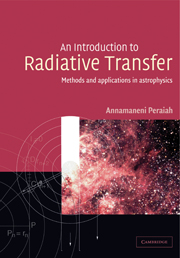Book contents
- Frontmatter
- Contents
- Preface
- Chapter 1 Definitions of fundamental quantities of the radiation field
- Chapter 2 The equation of radiative transfer
- Chapter 3 Methods of solution of the transfer equation
- Chapter 4 Two-point boundary problems
- Chapter 5 Principle of invariance
- Chapter 6 Discrete space theory
- Chapter 7 Transfer equation in moving media: the observer frame
- Chapter 8 Radiative transfer equation in the comoving frame
- Chapter 9 Escape probability methods
- Chapter 10 Operator perturbation methods
- Chapter 11 Polarization
- Chapter 12 Polarization in magnetic media
- Chapter 13 Multi-dimensional radiative transfer
- Symbol index
- Index
Chapter 9 - Escape probability methods
Published online by Cambridge University Press: 05 June 2012
- Frontmatter
- Contents
- Preface
- Chapter 1 Definitions of fundamental quantities of the radiation field
- Chapter 2 The equation of radiative transfer
- Chapter 3 Methods of solution of the transfer equation
- Chapter 4 Two-point boundary problems
- Chapter 5 Principle of invariance
- Chapter 6 Discrete space theory
- Chapter 7 Transfer equation in moving media: the observer frame
- Chapter 8 Radiative transfer equation in the comoving frame
- Chapter 9 Escape probability methods
- Chapter 10 Operator perturbation methods
- Chapter 11 Polarization
- Chapter 12 Polarization in magnetic media
- Chapter 13 Multi-dimensional radiative transfer
- Symbol index
- Index
Summary
Exact numerical methods become costly in terms of computer time when the radiation field is coupled with hydrodynamics. In such situations one needs methods which are fast and give insight into the physics of the problem in an easy and quick manner. Escape probability methods satisfy these requirements to a large extent and therefore became popular. There are ‘first order methods’ due to Biberman, Holstein, Sobolev and Zanstra, which are reviewed by Irons (1979a,b). The methods due to Athay (1972a,b), Rybicki (1972), Frisch and Frisch (1975), Canfield et al. (1981, 1984), Scharmer (1981, 1983, 1984) and others are the so called ‘second order methods’. We shall describe these and others methods in this chapter. These methods have been reviewed by Rybicki (1984).
Nordlund (1984) developed a method for obtaining an iterative solution of radiative transfer in a spherically symmetric atmosphere using a single ray approximation. The convergence is achieved in 2–3 iterations to give an accuracy better than 1% in the source function.
The Monte Carlo technique has been used by several authors (see, for example, Magnan (1970), Panagia and Ranieri (1973); Pozdnyakov et al. (1976)).
Surfaces of constant radial velocity
The geometrical region from which most of the observed emission at a given frequency x comes is likely to be a thin zone centred on a surface of constant radial velocity in such a way that υz = µυr = x, where the term radial velocity means the velocity along the line of sight, which is different from υr the velocity along the radius vector (see Mihalas (1978)) measured from the centre of the star.
Information
- Type
- Chapter
- Information
- An Introduction to Radiative TransferMethods and Applications in Astrophysics, pp. 264 - 329Publisher: Cambridge University PressPrint publication year: 2001
